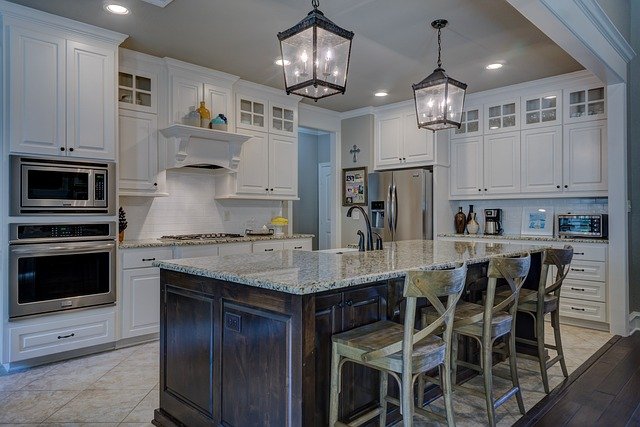Here Are The New Kitchen Trends In 2025
The kitchen remains the heart of New Zealand homes, and 2025 brings exciting design innovations that blend functionality with contemporary aesthetics. From sustainable materials to smart technology integration, this year's trends reflect a growing emphasis on personalised spaces that cater to modern lifestyles. Whether you're planning a complete renovation or considering targeted updates, understanding these emerging trends can help you create a kitchen that feels both current and timeless while adding value to your property.

How Are Kitchen Designs Evolving This Year?
Contemporary kitchen designs in 2025 emphasise clean lines with warm, inviting elements. The stark minimalism of previous years is giving way to more textured surfaces and layered materials. Natural stone countertops paired with warm timber accents create visual interest without overwhelming the space. Curved elements are making a notable comeback, from rounded island corners to arched cabinet details, softening the geometric precision that has dominated recent design trends.
Colour palettes are shifting towards earthy tones, with sage greens, warm terracotta, and deep navy blues replacing the all-white kitchens of the past decade. These colours work particularly well in New Zealand’s varied lighting conditions, from bright coastal homes to more sheltered urban environments. Mixed metal finishes are also gaining popularity, allowing homeowners to combine brass, copper, and matte black elements for a more personalised aesthetic.
What Kitchen Cabinet Renovation Options Are Popular?
Kitchen cabinet renovation has become increasingly sophisticated, with homeowners opting for updates that maximise both storage and visual appeal. Two-toned cabinet schemes are particularly trending, where upper and lower cabinets feature complementary but distinct colours or finishes. This approach allows for greater design flexibility while maintaining visual cohesion throughout the space.
Fluted and reeded cabinet fronts are replacing flat-panel designs, adding texture and visual depth. These vertical grooves work exceptionally well with both traditional and contemporary design schemes. Handle-less cabinets continue to grow in popularity, with push-to-open mechanisms and integrated finger pulls creating sleek, uninterrupted surfaces. For those preferring traditional hardware, oversized handles in mixed metals are becoming statement features rather than purely functional elements.
Which Door Replacement Services Are Available Locally?
When considering kitchen updates, many New Zealand homeowners are discovering that door replacement offers significant transformation potential without the expense of complete cabinet reconstruction. Local services typically offer comprehensive solutions including measurement, custom manufacturing, and professional installation. This approach proves particularly valuable for structurally sound cabinets that simply need aesthetic refreshing.
Professional kitchen door replacement companies in your area generally provide extensive material options, from traditional timber veneers to modern laminate and painted finishes. Many offer design consultation services, helping homeowners select styles that complement existing kitchen elements while achieving their desired aesthetic goals. The process typically involves detailed measuring, custom manufacturing to existing cabinet specifications, and professional installation with minimal disruption to daily routines.
| Service Provider | Specialisation | Typical Cost Range (NZD) |
|---|---|---|
| Kitchen Studio | Custom cabinet doors and hardware | $200 - $800 per door |
| Refresh Renovations | Complete door replacement packages | $3,000 - $8,000 per kitchen |
| Local Cabinet Makers | Bespoke timber and painted finishes | $300 - $1,000 per door |
| Trade Depot | Standard replacement doors | $150 - $400 per door |
Prices, rates, or cost estimates mentioned in this article are based on the latest available information but may change over time. Independent research is advised before making financial decisions.
How Is Technology Shaping Modern Kitchens?
Smart technology integration has moved beyond novelty to become genuinely practical in 2025 kitchen designs. Induction cooktops with integrated ventilation systems eliminate the need for traditional range hoods, creating cleaner sight lines and more flexible layout options. Smart appliances now offer better integration with home automation systems, allowing coordinated operation and energy management.
Charging stations are being seamlessly incorporated into kitchen islands and benchtops, with wireless charging surfaces and discrete USB outlets maintaining clean aesthetics while supporting modern device usage patterns. Under-cabinet lighting has evolved to include colour-changing LED systems that adjust throughout the day, supporting both task lighting and ambient mood creation.
What Sustainable Materials Are Trending?
Environmental consciousness is driving material choices in 2025 kitchen renovations. Recycled timber, particularly from New Zealand’s sustainable forestry programs, is increasingly popular for both structural and decorative elements. Recycled glass countertops offer durability comparable to traditional stone while supporting circular economy principles.
Low-VOC paints and finishes are becoming standard rather than premium options, improving indoor air quality without compromising aesthetic results. Bamboo and cork are gaining acceptance as cabinet and flooring materials, offering rapid renewability with surprising durability. These materials work particularly well in New Zealand’s varied climate conditions while supporting sustainable building practices.
Kitchen renovations in 2025 reflect a maturing design sensibility that balances aesthetic appeal with practical functionality. The trends emerging this year suggest a move towards more personalised, sustainable, and technologically integrated spaces that serve as genuine living environments rather than purely functional work areas. Whether pursuing complete renovation or targeted updates, these design directions offer numerous opportunities to create kitchens that feel both contemporary and enduringly appealing.




